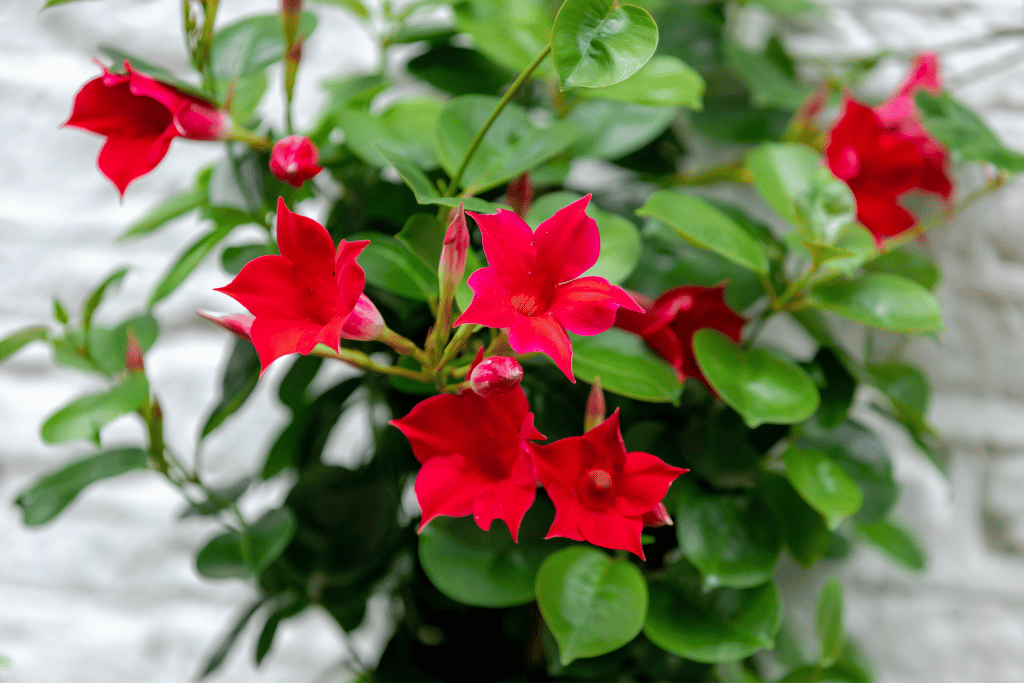Rio Dipladenia, with its vibrant flowers and lush foliage, is a standout plant that can bring a touch of tropical beauty to any garden.
Native to South America and also known by its scientific name, Dipladenia sanderi, this plant is appreciated for its ability to thrive with minimal care, making it suitable for gardeners of all levels.
Admired for its drought tolerance, the Rio Dipladenia stores water in its tubers, allowing it to withstand dry periods with ease.
Key Takeaways
- Rio Dipladenia is a drought-resistant plant ideal for both novice and experienced gardeners.
- It requires full sun and thrives in warm temperatures to ensure prolific blooming.
- Proper care includes understanding the specifics of watering, pruning, and fertilizing.
Optimal Growing Conditions
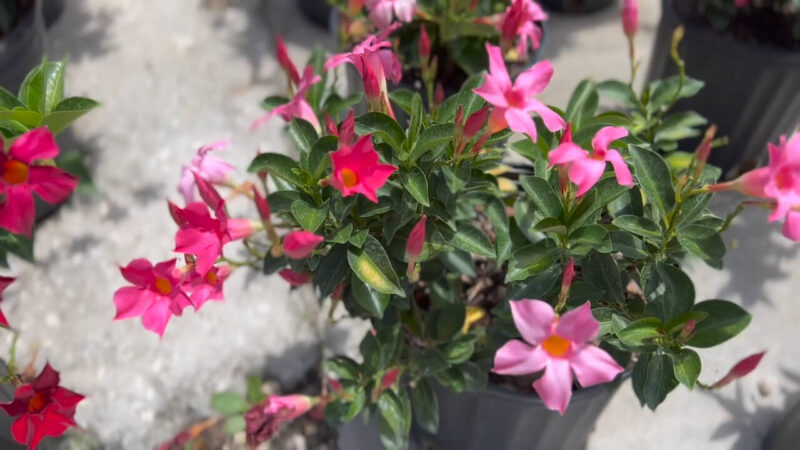
Providing the right environment for Rio Dipladenia is key to ensuring vigorous growth and abundant flowering. Attention to soil, water, light, and humidity sets the stage for a thriving plant.
| Aspect | Details |
|---|---|
| Soil Requirements |
|
| Watering Regimen |
|
| Light and Temperature |
|
| Humidity Preferences |
|
Care and Maintenance – Tips
Proper care and maintenance of the Rio Dipladenia ensure a healthy plant with vibrant blooms. This includes regular pruning, appropriate fertilization, and special attention during the winter months to protect the plant from colder temperatures.
Pruning and Deadheading
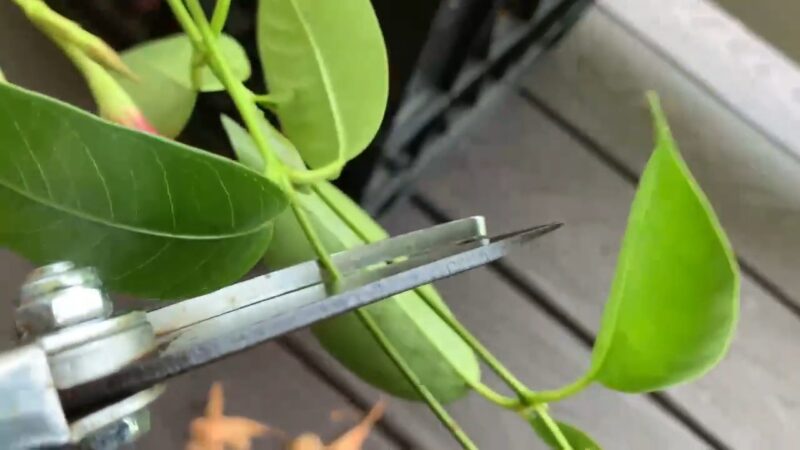
Pruning is essential to maintain the shape of the Rio Dipladenia and encourage new growth. It’s best to prune in the spring, cutting back any overgrown or dead stems to promote a bushier appearance.
Deadheading, the removal of faded or dead flowers, should be done regularly to enhance further blooming and prevent the plant from putting energy into seed production.
Feeding and Fertilizing
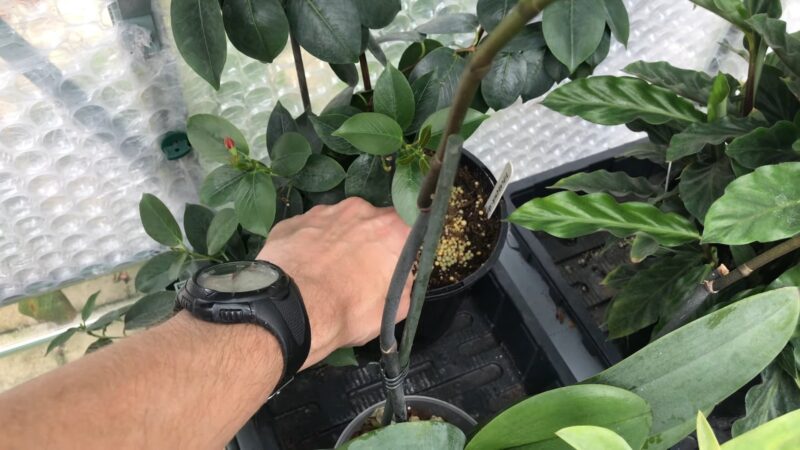
- For optimal growth, the Rio Dipladenia should be fertilized with an all-purpose fertilizer every two weeks during the growing season.
- Fertilizers rich in phosphorus can promote abundant blooms. During the dormant winter period, reduce fertilization to once a month to match the plant’s slower metabolism.
Winter Care
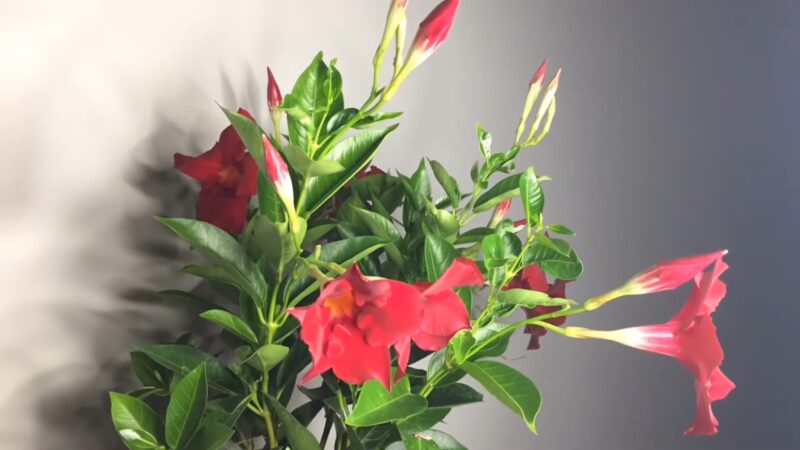
During winter, Rio Dipladenia enters a dormant state and requires less water. However, the plant should not be exposed to temperatures below 45°F. If potted, consider bringing the plant indoors to a sunny spot.
In regions with mild winters, ensure that the soil is well-drained to prevent root rot and shield the plant from frost.
Propagation Techniques
All of you who are looking to expand their collection of Rio Dipladenia have two primary methods at their disposal: propagation from seeds or cuttings.
The right technique ensures healthy growth and successful establishment of new plants.
Seed vs. Cuttings
Seeds:
- Advantages: Seeds can produce a large number of plants at a lower cost.
- Disadvantages: The genetic variability in seeds may result in plants that differ from the parent in terms of flower color and vigor.
Cuttings:
- Advantages: Propagating from cuttings creates a clone of the parent plant, ensuring the offspring retains the desired characteristics.
- Methods:
- Take a four- to six-inch cutting from the green, pliable tip of the plant.
- Use rooting hormone to encourage root growth.
Rooting and Transplanting
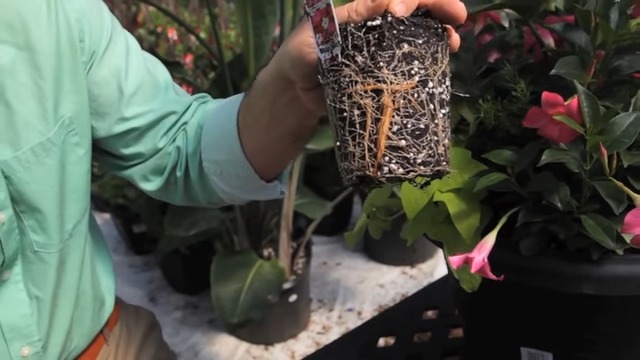
Rooting:
- Steps:
- Dip the cut end of the cutting into a rooting hormone.
- Plant the cutting in moist, well-draining potting mix.
- Environment: Maintain a warm, bright environment to facilitate rooting, with temperatures around 60-75°F.
Transplanting:
- Timing: Transplant the cutting once substantial roots have formed, typically after a few weeks.
- Care: After transplanting, keep moisture high and maintain the warm conditions to ease the transition for the new plant.
Common Pests and Diseases
Rio Dipladenia plants are susceptible to several pests and diseases, which can hamper their growth. Timely identification and treatment are crucial to maintaining a healthy plant.
Identifying and Treating Pest Infestations
| Pest | Appearance and Location | Treatment Methods |
|---|---|---|
| Spider Mites | Small red/brown dots, underside of leaves | Neem oil |
| Whiteflies | Small white, flying, underside of leaves | Yellow sticky traps, Neem oil sprays |
| Aphids | Small, soft-bodied, new growth/undersides | Strong water spray, Insecticidal soaps, Neem oil |
| Mealybugs | Small, cottony, suck plant juices | Alcohol-soaked cotton swabs, Neem oil |
| Scale Insects | Small bumps on stems and leaves | Scraping off, Neem oil |
How to Prevent and Treat Diseases?
- Root Rot: This is often caused by overwatering, leading to a fungal infection. Ensuring proper drainage and avoiding overwatering are critical to prevent root rot.
- Bacterial Infections: Manifest as leaf spots or blights and can spread quickly. Pruning affected areas and applying copper-based fungicides help manage these infections.
- Fungal Diseases: Including powdery mildew and leaf spot, can be managed with good air circulation, proper spacing, and fungicides if necessary.
For both pests and diseases, maintaining clean growing conditions and monitoring plants regularly are key preventive measures.
Safe Gardening Practices
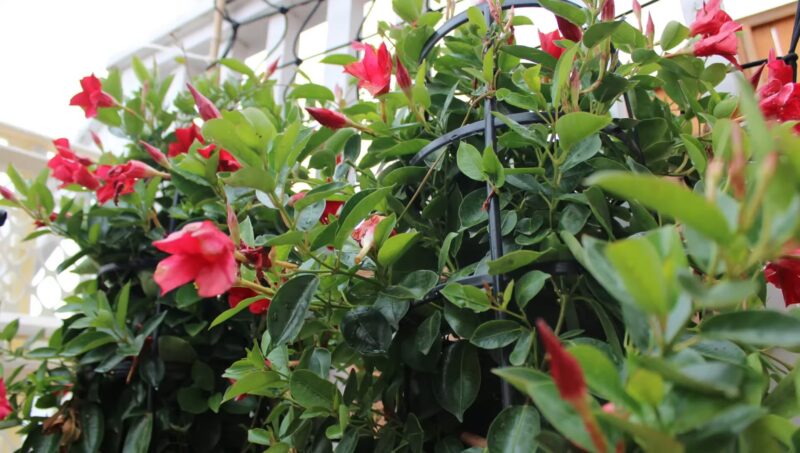
When tending to Rio Dipladenia plants, gardeners should be aware of the plant’s characteristics to ensure a safe gardening environment for themselves, their pets, and the local wildlife.
- Non-Toxic Nature: Rio Dipladenia plants are non-toxic, which means they do not pose a serious threat to pets or local wildlife like deer and rabbits.
- Irritation from Sap: While not toxic, the milky white sap of Rio Dipladenia may irritate the skin or eyes upon contact. Gardeners should wear gloves and protective eyewear when handling the plant, especially during pruning or when there is a risk of sap exposure.
- Sap Clean-up: If sap gets on the skin, it should be washed off immediately with soap and water to prevent irritation.
- Wildlife Considerations: Although Rio Dipladenia is not a favorite of deer or rabbits due to its sap, installing a fence or specific plant deterrents can be considered to protect the plant if necessary.
| Precaution | Reason |
| Wear Gloves | To avoid skin irritation from the plant sap. |
| Protective Eyewear | To prevent eye irritation from accidental sap contact. |
| Wash Skin After Contact | To quickly remove sap and reduce the risk of irritation. |
| Wildlife Deterrents | To protect the plant from curious animals, though rarely needed. |
Gardeners should ensure that pets are discouraged from chewing on the plant as a precaution, even though it is not toxic, to avoid any potential discomfort from the sap.
These practices help maintain a harmonious garden space that is welcoming and safe for everyone.
Landscape and Garden Design
When incorporating Rio Dipladenia into a landscape, it should be noted that this versatile plant serves well both as an outdoor garden feature and an indoor houseplant.
In outdoor settings, they are known to create a visual impact when utilized in garden beds or as climbing vines on trellises, offering a lush, tropical feel.
Their ability to flourish in hanging baskets also makes them a charming addition to balconies and patios.
In Garden Beds:
- Use as a border plant for a pop of color.
- Pair with other sun-loving perennials for a varied display.
As a Climbing Vine:
- Train on arbors or trellises.
- Suitable for covering walls or fences.
In Hanging Baskets:
- Perfect for adding vertical interest.
- Allow vines to cascade for an eye-catching display.
Indoor Gardening:
- Thrive in bright, indirect sunlight when kept indoors.
- Can be placed in well-lit atriums or sunrooms.
Whether used in a formal garden setting or as a more casual landscape feature, this plant’s vibrant flowers add a touch of elegance.
For a cohesive garden design, consistent pruning will keep Rio Dipladenia looking neat and prevent overgrowth in smaller spaces.
Gardeners should ensure proper support structures are in place for its vining habit and remember to transition the plant indoors if temperatures drop below 45°F.
With these considerations in mind, one can confidently incorporate Rio Dipladenia into their gardening projects, ensuring both beauty and success in their horticultural endeavors.
Attracting Pollinators
The Rio Dipladenia is a flowering plant that is potent in attracting a variety of pollinators due to its brightly colored, trumpet-shaped flowers and sweet fragrance.
These attributes are essential in supporting local wildlife, including butterflies, hummingbirds, and ladybugs.
Flower Appeal
The bloom of Rio Dipladenia serves as a magnet for pollinators. Its vibrant-hued, trumpet-shaped flowers offer an accessible and attractive target for butterflies and hummingbirds.
The abundant flowering throughout the growing season ensures that pollinators are drawn consistently to the garden.
Supporting Wildlife
By planting Rio Dipladenia, gardeners contribute to local biodiversity. The plant provides not only nectar but also serves as a habitat for beneficial insects like ladybugs, which help control pests.
This mutualistic relationship supports both the flourishing of wildlife and the health of the plant.
Growth and Support Structures
Rio Dipladenia is a hardy, vining plant that flourishes with proper growth support, such as trellises, to accommodate its climbing nature.
Choosing the Right Trellis
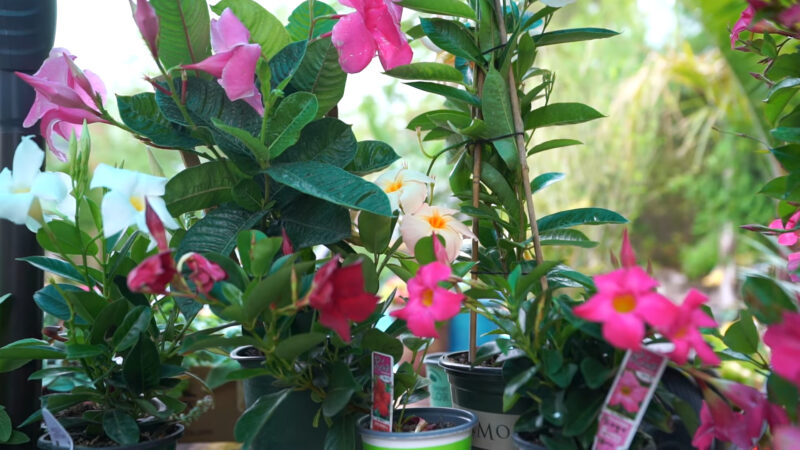
To ensure optimal growth for Rio Dipladenia, selecting an appropriate trellis is crucial. The trellis should be sturdy enough to hold the weight of the plant as it matures.
Metal or wooden trellises with a grid or lattice design offer the best support, allowing tendrils to weave through and secure the plant’s upward growth. It is essential to install the trellis at the time of planting to avoid damaging the roots later on.
Training Your Dipladenia
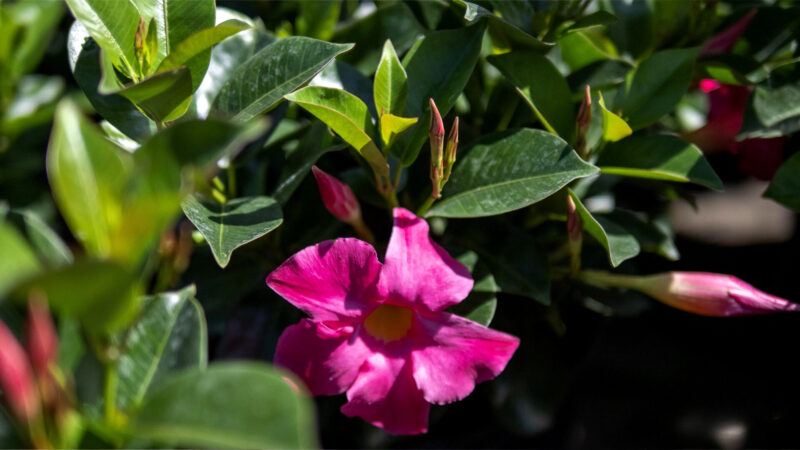
Training Rio Dipladenia to climb a trellis helps maintain the plant’s structure and enhances its aesthetic appeal. Begin by gently tying the vine’s base to the trellis with soft plant ties, avoiding damage to the stems.
As the plant grows, guide the vines through the trellis’ openings, securing them loosely to encourage upward growth. Regular training and adjusting of the ties will maintain the plant’s shape and support its continued growth.
FAQs
Can Rio Dipladenia be grown in indoor containers?
Yes, it can. The plant thrives in well-lit areas like sunrooms or atriums. Ensure the container has good drainage and use a quality potting mix.
Is it necessary to repot Rio Dipladenia annually?
Repotting Rio Dipladenia annually is not always necessary. It depends on the growth of the plant. If it outgrows its pot or the soil becomes depleted, then it’s time to repot.
How can I encourage more blooms in my Rio Dipladenia?
To encourage more blooms, ensure your plant receives enough sunlight and consider using a phosphorus-rich fertilizer during the growing season. Also, regular deadheading of spent blooms can promote further flowering.
Can Rio Dipladenia be grown as a ground cover?
While this plant is typically grown as a climbing vine or in containers, it can be used as ground cover if provided with enough space to spread and adequate sunlight.
Are there any specific pruning techniques for shaping Rio Dipladenia as a climbing vine?
When training the plant as a climbing vine, prune to encourage lateral growth which gives a fuller appearance. Trim back any overly long or unruly vines, especially after the blooming season.
Final Thoughts
In conclusion, caring for Rio Dipladenia involves following specific guidelines: ensure ample sunlight, regular watering, proper soil drainage, and occasional fertilization.
Protect the plant from extreme temperatures. By adhering to these best practices, this plant will thrive, displaying vibrant blooms and robust growth.
Related Posts:
- How To Clean Hydro Flask? The Best Practices
- Herbivore Teeth - Dental Adaptations for Plant-Based Diets
- 18 Dog Breeds That Begin With C - Characteristics,…
- 3 Dog Breeds That Begin With O - Characteristics & Care
- How Do Red Foxes Survive Winter? Survival Guide
- Compost 101: A Beginner's Guide to Organic Composting


